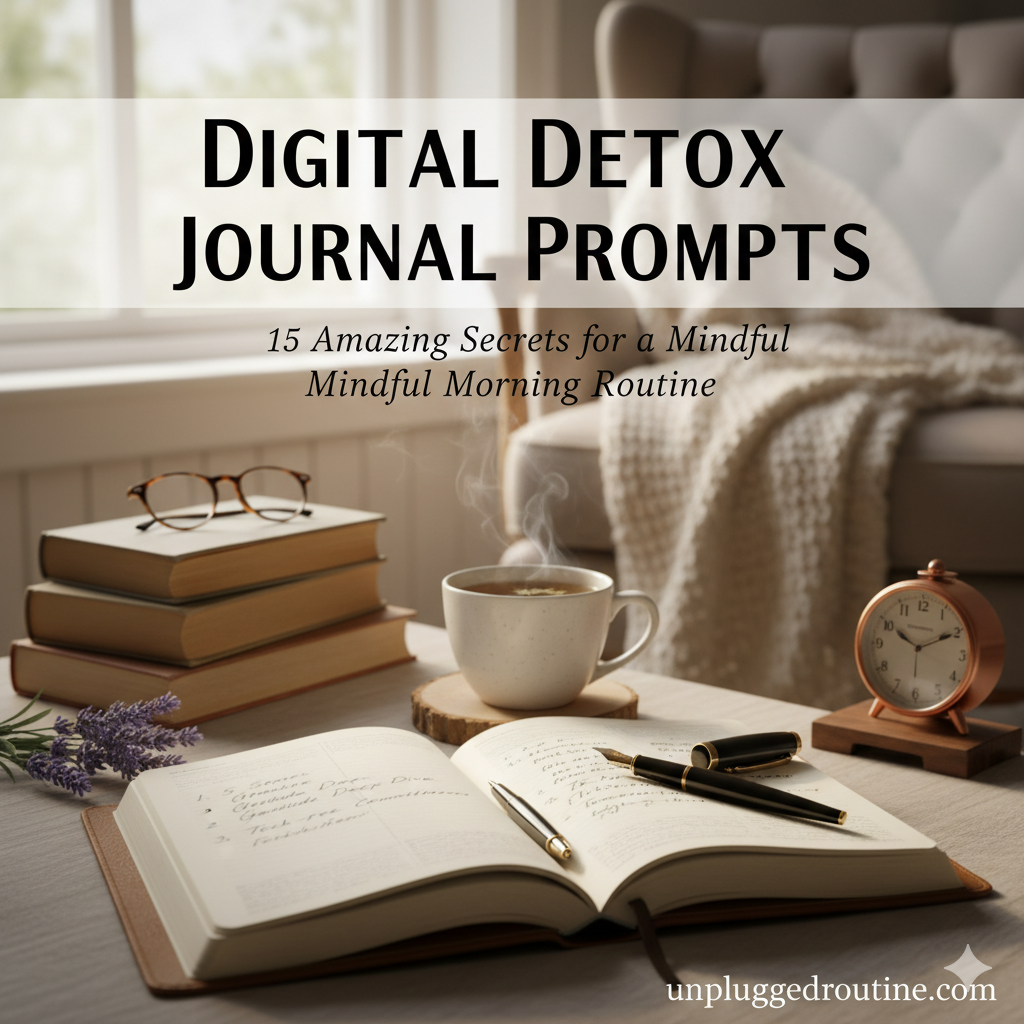Are You Letting Your Phone Steal Your Morning?
Imagine this: The alarm goes off, and before your feet even touch the floor, your hand is already grabbing your phone. Sound familiar?
That tiny, glowing rectangle instantly bombards you with a full day’s worth of stress: emails, headlines, social media comparisons, and notifications that scream for your attention.
Before you’ve even had your first sip of coffee, your mind is in reactive mode, running on digital fuel and other people’s agendas.
It’s time for a change. It’s time to reclaim the single most important part of your day: your morning.
A Digital Detox Journal is the powerful, simple secret to making that change. It’s a dedicated, screen-free space to anchor your mind in the present and set an intentional, calm tone for the next 24 hours.
If you’re ready to trade that morning scroll for genuine calm, keep reading. We’ve compiled 15 amazing Digital Detox Journal Prompts—grouped by theme—to help you build an incredible, mindful morning routine.
Why Journaling is Your Morning Digital Detox Key
You already know a digital detox is about disconnecting from devices. But a successful detox is also about reconnecting with yourself. Journaling is the bridge.
The first few minutes of the day are critical. When you reach for a pen and paper instead of a screen, you interrupt the automatic cycle of digital distraction.
This simple act lowers your cortisol (stress) levels and stops the dopamine roller coaster that social media loves to run. It primes your brain for focus, gratitude, and true self-reflection.
Think of it this way: Journaling helps you process your thoughts on your terms, not the internet’s. It’s an act of mental self-care, and it’s the best way to ensure your digital detox sticks all day long.

Phase 1: Mindful Presence & Gratitude Prompts (The Grounding)
The goal of a mindful morning is simple: to be present. These prompts help you slow down, notice your surroundings, and cultivate genuine gratitude before the day’s chaos begins. This is how you shift from ‘digital-reaction’ to ‘real-life-connection.’
1. The Five Senses Check-In
Prompt: Describe what you are experiencing right now using only your five senses (sight, sound, smell, taste, touch). What is one small, non-digital detail you are noticing for the first time today?
Why it works: This is a powerful grounding technique. It immediately pulls your attention away from the abstract world of the internet and firmly into your physical environment. It forces you to pause and appreciate the simple realities of the moment.
2. The Gratitude Deep Dive
Prompt: Go beyond the obvious. Write down three unexpected things you are grateful for this morning, and explain the exact feeling each one gives you.
Why it works: Many people write “I’m grateful for my health.” This prompt pushes you deeper. Maybe you’re grateful for the quiet hum of the refrigerator (a sign of working infrastructure) or the perfectly brewed coffee (a sign of a relaxing ritual). Connecting the thing to the feeling amplifies the positive emotion.
3. The Tech-Free Commitment
Prompt: What is one specific, screen-free activity I can dedicate myself to for the first hour after waking up today? Detail what you will do and how you anticipate it will make you feel.
Why it works: This prompt establishes a clear boundary for the day. Setting an intention in the morning makes you far more likely to stick to your digital detox goals. This is your personal pledge for a peaceful start.
Phase 2: Self-Reflection & Habit Prompts (The Insight)
The digital world often prevents us from truly seeing our habits and behaviors. These prompts are designed to peel back those layers, giving you honest insight into your relationship with technology and your own mind.
4. The Digital Impulse Log
Prompt: When was the last time I instinctively reached for my phone, and what emotion was I trying to avoid or fill in that exact moment?
Why it works: This is crucial for identifying your true “digital triggers.” Were you bored? Anxious? Lonely? By naming the underlying emotion, you gain power over the impulse, transforming a reflexive action into a conscious choice.
5. The Energy Audit
Prompt: Name three activities from yesterday that drained your energy. Now, name three non-digital activities that fueled your energy. What pattern emerges?
Why it works: Often, the draining activities are linked to excessive screen time (doomscrolling, work emails, social comparison). This side-by-side comparison provides clear evidence of what truly supports your well-being, motivating you to choose the fuel-rich options today.
6. The “Missing Out” Myth
Prompt: Write a short paragraph about the worst thing you imagine missing out on today because you chose to unplug. Now, write a paragraph about the best thing you expect to gain.
Why it works: This tackles FOMO (Fear of Missing Out) head-on. By externalizing the fear and contrasting it with a tangible, positive gain (like focus, peace, or time), you de-power the anxiety and strengthen your resolve.
7. The Ideal Self
Prompt: If my best, most productive, and happiest self had just woken up without checking their phone, what is the first thought they would have, and what is the first action they would take?
Why it works: This taps into aspirational identity. Instead of focusing on “don’t check the phone,” you focus on “becoming the person who doesn’t need to check the phone.” It’s a positive, action-oriented visualization.
Phase 3: Intention Setting & Planning Prompts (The Action)
Mindfulness isn’t just about feeling good; it’s about making good choices. These prompts translate your quiet morning reflections into concrete, screen-free actions that will define your day.
8. The Day’s Single Focus
Prompt: What is the single most important, non-digital task or goal I want to complete by lunchtime? Break it down into the first three steps I need to take right now.
Why it works: It forces you to prioritize real-world action over digital to-dos. By defining the first three physical steps, you overcome inertia and create immediate, tangible momentum that a screen cannot provide.
9. The Relationship Builder
Prompt: Today, how will I use the extra focus from my screen-free morning to improve one key relationship? What specific, non-digital interaction will I initiate?
Why it works: A huge benefit of a digital detox is improved relationships. This prompt makes that benefit actionable—whether it’s having a fully present conversation at breakfast, writing a thoughtful note, or planning an offline activity.
10. The Phone’s Place
Prompt: At what specific times today will I allow myself to check my device, and for what explicit purpose? (e.g., 12:00 PM for 15 minutes to check email).
Why it works: This shifts your phone usage from default to intentional. By pre-scheduling “digital appointments,” you contain the time sink and prevent the endless pull of checking notifications “just in case.”
Phase 4: Creative & Future-Focused Prompts (The Expansion)
When the digital noise is silenced, your own creative voice can finally be heard. These prompts encourage deeper thinking, visualization, and connection to your long-term goals and passions.
11. The Offline Hobby Dream
Prompt: If I had two totally phone-free hours this evening, what old hobby would I dust off, or what new skill would I start learning? What single item do I need to prepare for that now?
Why it works: This re-ignites your passion for offline activities. The focus on what you need to prepare now ensures you’re setting yourself up for success later in the day, making the new habit feel less daunting.
12. The Freedom Feeling
Prompt: Describe in detail the feeling of freedom that comes from being truly unplugged. What sensory words describe this feeling (e.g., light, open, clear, quiet)?
Why it works: This is a powerful motivational tool. By visualizing and documenting the positive payoff of the digital detox, you create a mental reward system that rivals the instant gratification of your device.
13. The Two-Year Vision
Prompt: Look two years into the future. What incredible thing will I have accomplished because I consistently chose a mindful morning routine over digital distraction?
Why it works: Connecting a small, daily habit (journaling) to a huge, long-term reward (a two-year vision) creates a profound sense of purpose and commitment. It frames the detox not as a sacrifice, but as a path to a better future.
The Practical Guide: Making Journaling a Daily Habit (The How-To)
A journal is only a powerful tool if you actually use it. Making these Digital Detox Journal Prompts a consistent part of your morning takes a small amount of strategy.

Step 1: Designate a Sacred Spot
Don’t write in bed. Create a specific, dedicated space in your home that is 100% tech-free. This could be a comfy chair, a desk by a window, or even a spot on the porch. Place your journal, a good pen, and maybe a cup of tea here. This physical boundary signals to your brain that it’s time to unplug and focus.
Step 2: Use an Analog Alarm
The phone cannot be your alarm. Invest in a simple, inexpensive physical alarm clock. This is your first line of defense. By leaving your phone in another room (the kitchen, the hallway), you remove the immediate temptation to check it first thing.
Step 3: Start Small, Stay Consistent
You don’t need to write a novel. Choose just one of the Digital Detox Journal Prompts from this list each morning. Commit to a simple 5-10 minute writing session. Consistency, even in small doses, is the secret to building a habit that lasts.
Step 4: The Power of the Pen
The physical act of writing by hand is a crucial part of the process. It engages your mind differently than typing and is inherently slower, which forces your thoughts to slow down and deepen. Resist the urge to use a digital journaling app for your morning detox ritual.
The Benefits You Will Immediately Feel (The Results)
Switching from a screen-based start to a journal-based one offers immediate, tangible rewards that quickly reinforce your new habit.
You’ll find your stress levels dropping before you even leave the house. By externalizing your anxieties on paper, they lose their power to control your mood.
Your attention span will sharpen. Instead of scattering your focus across a dozen apps, you direct it to one thing: your thoughts. This clarity carries through to your work and your conversations.
You will also likely experience an overall better mood. Gratitude, presence, and intention setting are powerful emotional stabilizers. You’re setting the tone for the day, not letting the internet set it for you.
Over time, this small habit snowballs. You’ll become more deliberate about all your technology use, ultimately spending more time on the things that truly matter—your health, your relationships, and your goals.
Your Unplugged Routine Starts Now
The frantic, reactive start to the day is a choice—but so is the calm, intentional, and mindful morning routine.
Your digital device offers connection to the world, but your journal offers connection to yourself. The latter must come first if you want the former to be healthy. These Digital Detox Journal Prompts are not just questions; they are invitations to a deeper, more peaceful life.
Choose one prompt today. Grab a pen. Feel the difference of an unplugged routine.
Ready to transform your mornings and your life? Checkout our Free 7-Day Mindful Morning Guide, which includes a printable version of all 15 prompts! Click here to start your jorney to lasting digital wellness now!